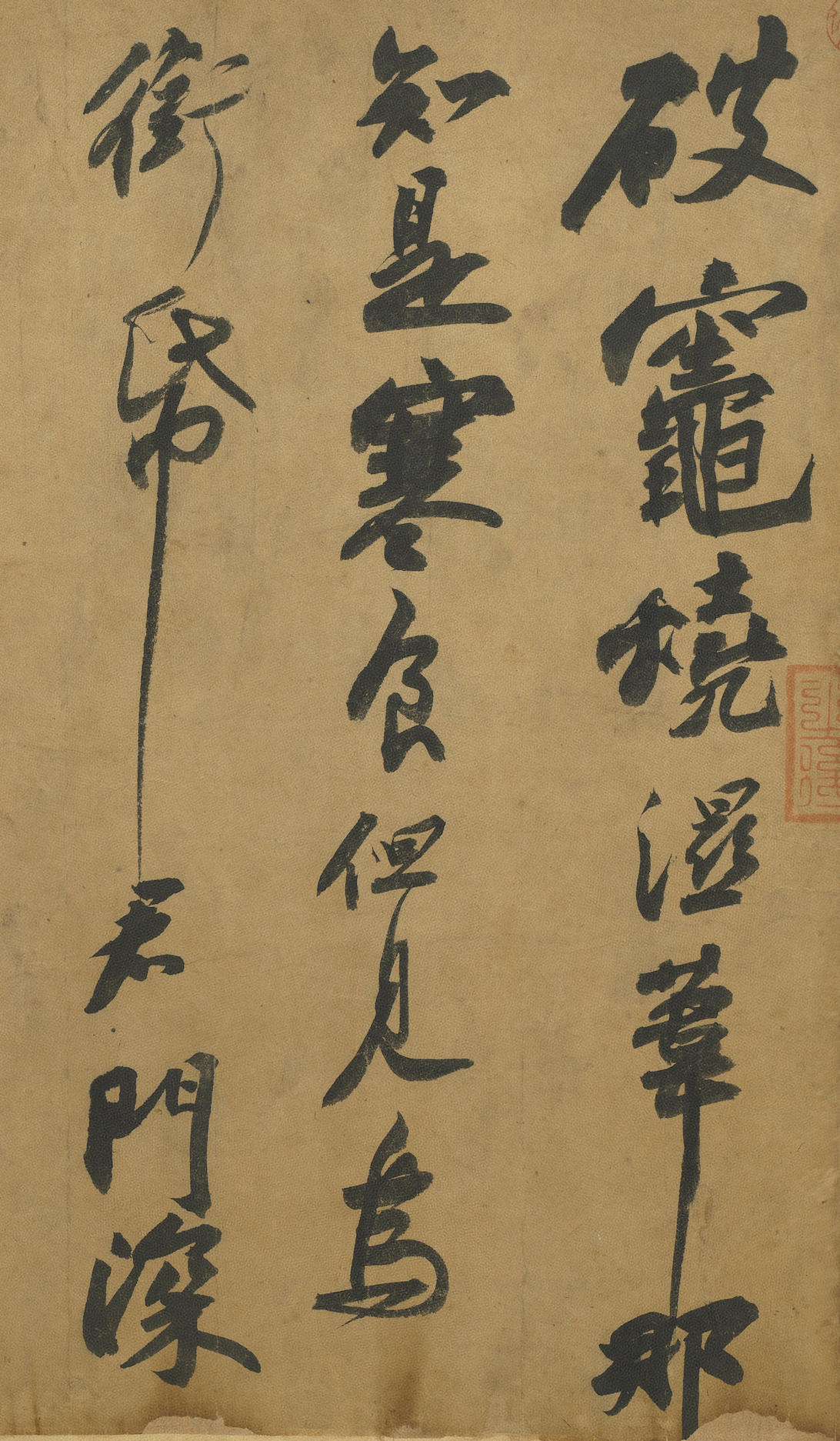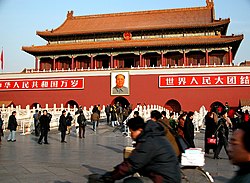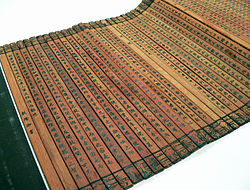Horizontal and vertical writing in East Asian scripts
From Wikipedia, the free encyclopedia
| This article contains Chinese text. Without proper rendering support, you may see question marks, boxes, or other symbols instead of Chinese characters. |
| This article contains Japanese text. Without proper rendering support, you may see question marks, boxes, or other symbols instead of kanji and kana. |
| This article contains Korean text. Without proper rendering support, you may see question marks, boxes, or other symbols instead of Hangul or hanja. |

Many East Asian scripts can be written horizontally or vertically. The Chinese, Japanese and Korean scripts can be oriented in either direction, while the traditional Mongolian script and its offshoots (like Manchu) are written vertically.
In Chinese, horizontal writing is known as hengpai (Chinese: 橫排; pinyin: héngpái; literally "horizontal alignment"), while vertical writing is known as shupai (traditional Chinese: 竪排; simplified Chinese: 竖排; pinyin: shùpái; literally "vertical alignment"). In Japanese, horizontal writing is called yokogaki (横書き, "horizontal writing", also known as yokogumi, 横組み) and vertical writing is called tategaki (縦書き, "vertical writing", also known as tategumi, 縦組み). In Korean, horizontal writing is called garosseugi (가로쓰기) or hoengseo (횡서; 橫書), and vertical writing is called serosseugi (세로쓰기) or jongseo (종서; 縱書).
Traditionally, Chinese, Japanese, and Korean are written vertically in columns going from top to bottom and ordered from right to left, with each new column starting to the left of the preceding one. The stroke order and stroke direction of Chinese characters (hanzi in Chinese, kanji in Japanese, hanja in Korean), Japanese kana, and Korean Hangul all facilitate writing in this manner. In addition, writing in vertical columns from right to left facilitated writing with a brush in the right hand while continually unrolling the sheet of paper or scroll with the left. In modern times, it has become increasingly common for these languages to be written horizontally, from left to right, with successive rows going from top to bottom, under the influence of European languages such as English.
Contents |
[edit] Differences between horizontal and vertical writing
Chinese characters, Japanese kana, and Korean hangul can be written horizontally or vertically. There are some small differences in orthography. In horizontal writing it is more common to use Arabic numerals, whereas Chinese numerals are more common in vertical text.
In these scripts, the positions of punctuation marks, for example the relative position of commas and full stops (periods), differ between horizontal and vertical writing. Punctuation such as the parentheses, quotation marks, book title marks (Chinese), ellipsis mark, dash, wavy dash (Japanese), proper noun mark (Chinese), wavy book title mark (Chinese), emphasis mark, and chōon mark (Japanese) are all rotated 90 degrees when switching between horizontal and vertical text.
Where a text is written in horizontal format, pages are read in the same order as English books, with the binding at the left and pages progressing to the right. Vertical books are printed the other way round, with the binding at the right, and pages progressing to the left.
Ruby characters, like furigana in Japanese or zhuyin in Traditional Chinese, which provide a phonetic guide for unusual or difficult-to-read characters, follow the direction of the main text. Example in Japanese, with furigana in red:
|
or |
|
Inserted text in the Roman alphabet is usually written horizontally, or turned sideways when it appears in vertical text, with the base of the characters on the left.
[edit] Right-to-left horizontal writing

Historically, vertical writing was the standard system, and horizontal writing was only used where a sign had to fit in a constrained space, such as over the gate of a temple or the signboard of a shop. This horizontal writing is in fact a special case of vertical writing in which each column contains just one character.
Therefore, before the end of WW2 in Japan, those signs were read right to left.
Today, the left-to-right direction is dominant in all three languages for horizontal writing: this is due partly to the influence of English, and partly to the increased use of computerized typesetting and word processing software, most of which does not directly support right-to-left layout of East Asian languages.
However, right-to-left horizontal writing is still seen in these scripts, in such places as signs, on the right-hand side of vehicles, and on the right-hand side of stands selling food at festivals. It is also used to simulate archaic writing, for example in reconstructions of old Japan for tourists, and it is still found in the captions and titles of some newspapers.
[edit] History
[edit] Chinese
The first printed Chinese text in horizontal alignment was Robert Morrison's "Dictionary of the Chinese language", published in 1815–1823 in Macau.
The earliest widely known Chinese publication using horizontal alignment was the magazine Science (科學). Its first issue in January 1915 explained the (then) unusual format:
- 本雜誌印法,旁行上左,並用西文句讀點之,以便插寫算術及物理化學諸程式,非故好新奇,讀者諒之。
- This magazine is printed so that it goes sideways from the top left, and is marked with Western punctuation. This is to make the insertion of mathematical, physical and chemical formulae convenient, not for the sake of novelty-hunting. We ask our readers to excuse us.
With the proliferation of horizontal text, both horizontal and vertical came to be used concurrently. Proponents of horizontal text argued that vertical text in right-to-left columns were smudged easily when written, and moreover demanded greater movement from the eyes when read. Vertical text proponents, on their part, considered horizontal text to be a break from established tradition.
After the success of the communist revolution in 1949, the People's Republic of China decided that horizontal text should be used. All newspapers in mainland China were changed from vertical to horizontal alignment on January 1, 1956. In Singapore, vertical writing also became rare. In Taiwan, Hong Kong, Macau, and among older overseas Chinese communities, horizontal writing has been gradually adopted since the 1990s. By the early 2000s, most newspapers in these areas had switched to left-to-right horizontal writing, either entirely or in a combination of vertical text with horizontal left-to-right headings.
[edit] Japanese
Horizontal text originally came in to Japanese in the Meiji era when the Japanese tried to print dictionaries for Western languages. Initially the dictionaries were printed in a mixture of horizontal Western and vertical Japanese text, which meant the book had to be rotated ninety degrees in order to read the Japanese. Because this was unwieldy, the idea of yokogaki came to be accepted. One of the first publications to partially use yokogaki was a German to Japanese dictionary (袖珍挿図独和辞書, Shūchinsōzu Dokuwa Jisho, "pocket illustrated German to Japanese dictionary") published in 1885 (Meiji 18).
At the very beginning of the change to horizontal alignment in Japan, in the Meiji era, there was a short-lived form called migi yokogaki (右横書き, literally "right yokogaki"), in contrast to hidari yokogaki, (左横書き, literally "left yokogaki"), the current standard. This resembled the right-to-left horizontal writing style of languages such as Arabic with line breaks on the left hand side of the page. It was probably based on the traditional single-row right-to-left writing. This form was never widely used, and has not survived.
[edit] Korean

Traditionally, Korean people also used vertical writing and the columns were read from right to left. After the 1980s, it became popular to use the horizontal writing system, and horizontal writing is usually read left to right.
In 1980s all major Korean newspapers were written using vertical writing, but in 1988, The Hankyoreh newspaper first introduced horizontal writing to newspapers. After 1990 all major newspapers changed writing style to horizontal, and today there are no major newspapers written in vertical writing.
[edit] Usage
[edit] Simplified Chinese

In Mainland China, Malaysia and Singapore, where the Simplified Chinese orthographical reform has been adopted, vertical writing is now very rare. Most publications are now printed in horizontal alignment, like English, and vertical alignment is generally used for artistic or aesthetic purposes, or when space constraints demand it, for example on the spines of books or when labeling maps or diagrams. However, calligraphy—in Simplified or Traditional Chinese—is invariably written vertically. Additionally, vertical text may still be encountered on some business cards and personal letters in Mainland China.
Horizontal writing is written left to right in the vast majority of cases, with a few exceptions such as bilingual dictionaries of Chinese and right-to-left scripts like Arabic, in which case Chinese may follow the right-to-left alignment. Right-to-left writing direction can also often be seen on the right side of tourist buses, as it is customary to have the text run (on both sides of the vehicle) from the front of the bus to its rear.
[edit] Japanese and Traditional Chinese

Both horizontal and vertical writing are used in Japan, as well as in Hong Kong, Macau and Taiwan where the Traditional Chinese orthography is used. Traditional Chinese is also used in mainland China in a few limited contexts, such as some books on ancient literature, or as an aesthetic choice for some signs on shops, temples, etc. In those contexts, both horizontal and vertical writing are used as well.

Vertical writing is commonly used for novels, newspapers, comics, and many other forms of writing. Because it goes downwards, vertical writing is invariably used on the spines of books. Some newspapers combine the two forms, using the vertical format for most articles but including some written horizontally, especially for headlines. Musical notation for some Japanese instruments such as the shakuhachi is written vertically.
Horizontal writing is easier for some purposes; academic texts are sometimes written this way since they often include words and phrases in other languages, which are more easily incorporated horizontally. Scientific and mathematical texts are nearly always written horizontally, since in vertical writing equations must be turned sideways, making them more difficult to read.
Similarly, English language textbooks, which contain many English words, are usually printed in horizontal writing. This is not a fixed rule, however, and it is also common to see English words printed sideways in vertical writing texts.
Computer text is usually presented in horizontal format; see Japanese language and computers.
Business cards in Japan (meishi) are often printed vertically in Japanese on one side, and horizontally in English on the other. Postcards and handwritten letters may be arranged horizontally or vertically, but the more formal the letter the more likely it is to be written vertically. Envelope addresses are usually vertical, with the recipient's address on the right and the recipient's name in the exact centre of the envelope. See also Japanese etiquette.
[edit] Calligraphy
In East Asian calligraphy, vertical writing remains the dominant direction. This is true even for calligraphy done in Simplified Chinese.
[edit] Comics
Japanese comics, also known as manga, tend to use vertical direction for text. Manga frames tend to flow in right-to-left horizontal direction. Frames in yonkoma manga tend to flow in a vertical direction. Page ordering is the same as books that use vertical direction: from right to left. Frames that are chronologically before or after each other use less spacing in between as a visual cue.
In some cases, horizontal writing may be used to indicate that a character is actually speaking in English instead of Japanese.
Some publishers that translate manga into European languages may choose to keep the original page order (a notable example is Shonen Jump magazine), while other publishers may reverse the page flow with use of mirrored pages.
[edit] Korean
In modern Korea, vertical writing is rare. Modern Korean is usually written in left-to-right horizontally. Vertical writing is only used when the writing space is long vertically and narrow horizontally, for example titles on the spines of books are usually written vertically. When a foreign language film is subtitled into Korean, the subtitles are sometimes written vertically at the right side of the screen.
In the Standard language (표준어; 標準語) of South Korea, punctuation marks are used differently in horizontal and vertical writing. Western punctuation marks are used in horizontal writing and the Japanese-style punctuation marks are used in vertical writing. However, vertical writing using Western punctuation marks is sometimes found.
[edit] Mongolian
Traditional Mongolian Script and its offshoots including Manchu script are rendered vertically. Characters within Mongolian text that can only be rendered horizontally are rotated by 90 degrees.
The columns are read from left to right.
[edit] Vertical writing and computers

Early computer installations were designed only to support left-to-right horizontal writing based on the Latin alphabet. Today, most computer programs do not fully support the vertical writing system; however, most advanced word processing and publication software which target the East Asian region support the vertical writing system either fully or to a limited extent.
Even though vertical text display is generally not well supported, composing vertical text for print has been possible. For example, on Asian editions of Windows, Asian fonts are also available in a vertical version, with font names prefixed by "@".[1] Users can compose and edit the document as normal horizontal text. When complete, changing the text font to a vertical font converts the document to vertical orientation for printing purposes.
[edit] References
- Nihongo Daihakubutsukan (日本語大博物館), author: Jun'ichirō Kida (紀田順一郎), publisher: Just System (ジャストシステム, Jasuto Shisutemu) ISBN 4-88309-046-9 (in Japanese), chapter 9, deals with the change from tategaki to yokogaki in modern Japanese.
- ^ Kaplan, Michael S. (2005-08-04). "Let's get vertical". MSDN Blogs. http://blogs.msdn.com/michkap/archive/2005/08/04/447759.aspx. Retrieved on 2008-08-23.
[edit] See also
[edit] External links







